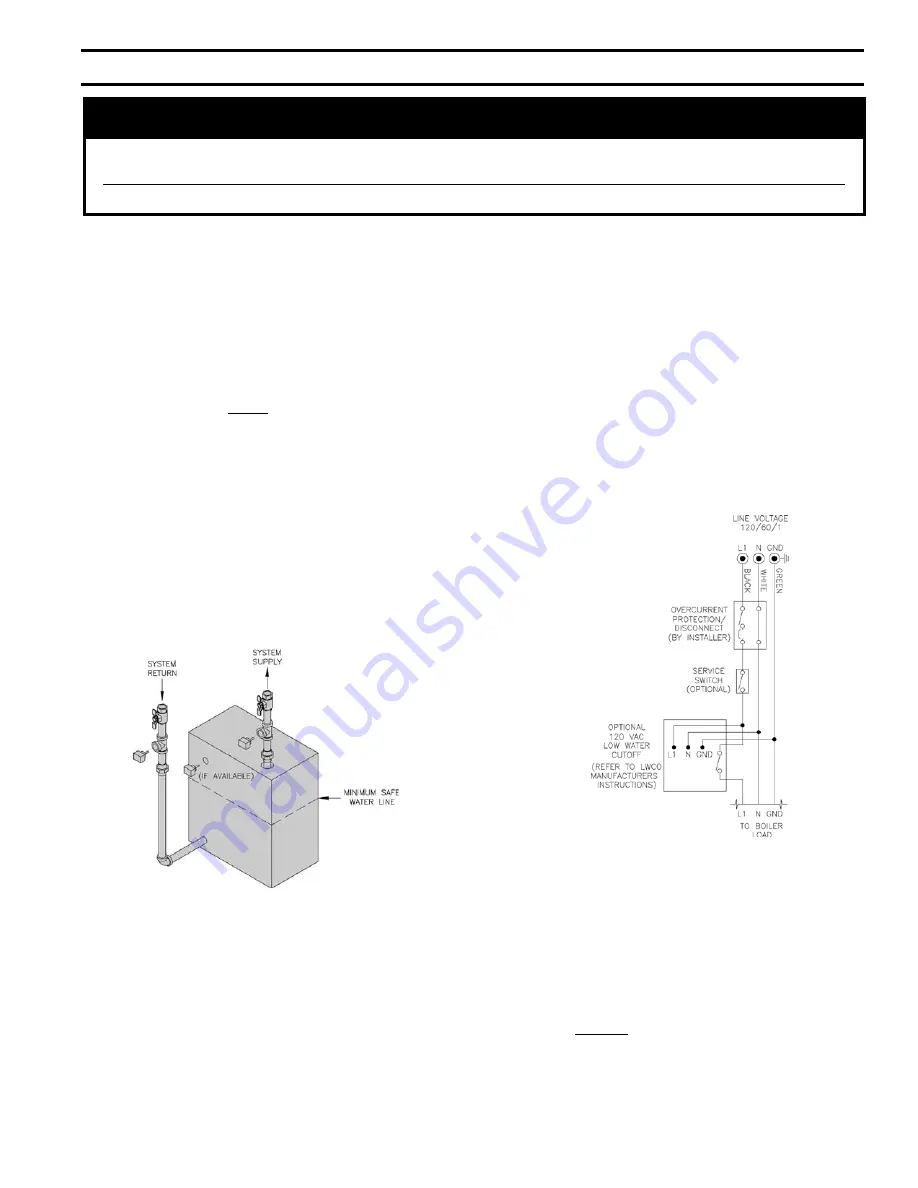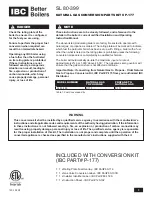
VI. Low Water Cut Off (LWCO)
A 24 VAC LWCO is used primarily for gas fired boilers
where a 24 volt control circuit exists within the boiler.
However, a 24 VAC LWCO can only be used if the
boiler manufacturer has provided piping and wiring
connections and instructions to allow for this
application.
How to Test
Shut off fuel supply. Lower water level until water
level is BELOW the LWCO. Generate a boiler demand
by turning up thermostat. Boiler should not attempt to
operate. Increase the water level by filling the system.
The boiler should attempt to operate once the water
level is above the LWCO.
Wiring of Typical LWCO
When
A low water cutoff is required to protect a hot water
boiler when any connected heat distributor (radiation) is
installed below the top of the hot water boiler (i.e.
baseboard on the same floor level as the boiler). In
addition, some jurisdictions require the use of a LWCO
with a hot water boiler.
Where
The universal location for a LWCO on both gas and oil
hot water boilers is above the boiler, in either the supply
or return piping. The minimum safe water level of a
water boiler is at the uppermost top of the boiler; that is,
it must be full of water to operate safely.
What Kind
Typically, in residential applications, a probe type
LWCO is used instead of a float type, due to their
relative costs and the simplicity of piping for a probe
LWCO.
How to Pipe
A “tee” is commonly used to connect the probe LWCO
to the supply or return piping, as shown below.
LWCO Location
draining the heating system. Many probe LWCO
manufacturers recommend an annual inspection of the
probe.
How to Wire
LWCO’s are available in either 120 VAC or 24 VAC
configurations. The 120 VAC configuration can be
universally applied to both gas and oil boilers by wiring
it in the line voltage service to the boiler (after the
service switch, if so equipped).
The presence of water in a properly installed LWCO
will cause the normally open contact of the LWCO to
close, thus providing continuity of the 120 VAC service
to the boiler.
It is recommended to supply power to the probe LWCO
with the same line voltage boiler service as shown
below.
Select the appropriate size tee using the LWCO
manufacturer’s instructions. Often, the branch
connection must have a
minimum
diameter to
prevent bridging between the probe and the tee. Also,
the run of the tee must have a minimum diameter to
prevent the end of the probe from touching or being
located too close to the inside wall of the run of the tee.
Ideally, manual shutoff valves should be located above
the LWCO and the boiler to allow for servicing. This
will allow probe removal for inspection without
G
N
I
N
R
A
W
.
)
O
C
W
L
(
f
f
O
t
u
C
r
e
t
a
W
w
o
L
t
e
k
r
a
m
r
e
t
f
a
n
a
ll
a
t
s
n
i
o
t
s
e
r
i
w
y
r
o
t
c
a
f
t
u
c
o
t
T
P
M
E
T
T
A
T
O
N
O
D
.
f
f
O
t
u
C
r
e
t
a
W
w
o
L
r
o
f
d
e
i
f
i
t
n
e
d
i
y
ll
a
c
i
f
i
c
e
p
s
s
n
o
i
t
c
e
n
n
o
c
e
s
u
y
l
n
O
.
s
n
o
i
t
c
u
r
t
s
n
i
s
'
r
e
r
u
t
c
a
f
u
n
a
m
)
O
C
W
L
(
f
f
O
t
u
C
r
e
t
a
W
w
o
L
e
h
t
w
o
ll
o
f
,
s
e
s
a
c
ll
a
n
I


































